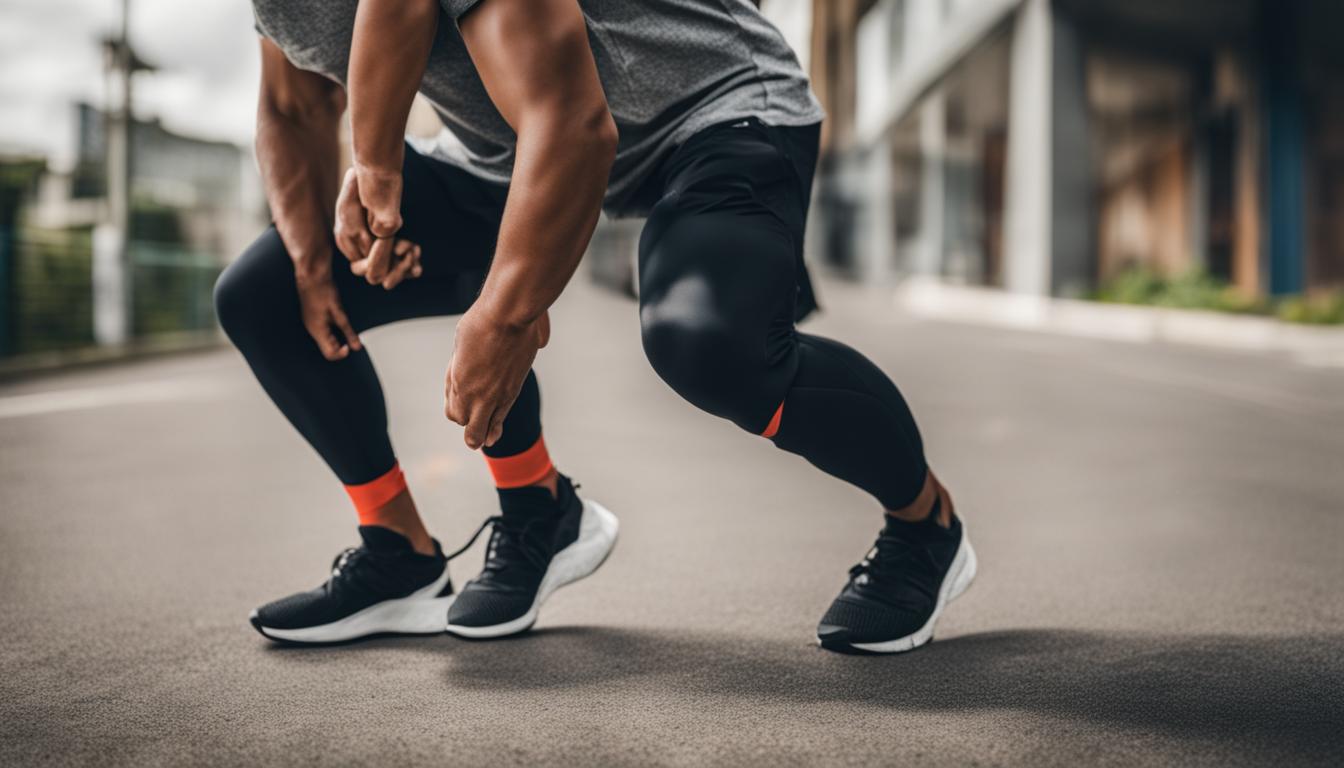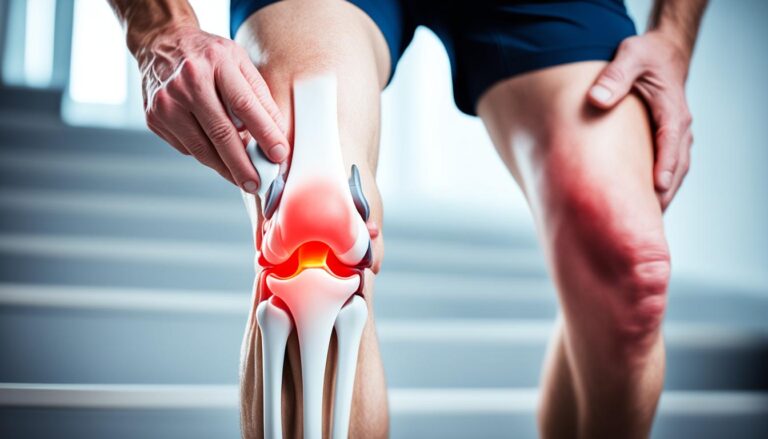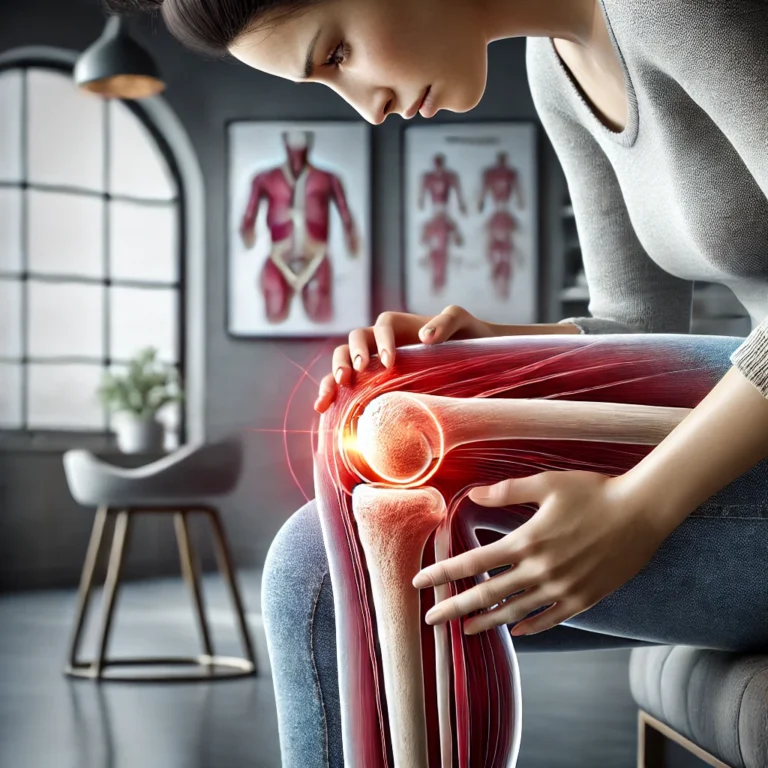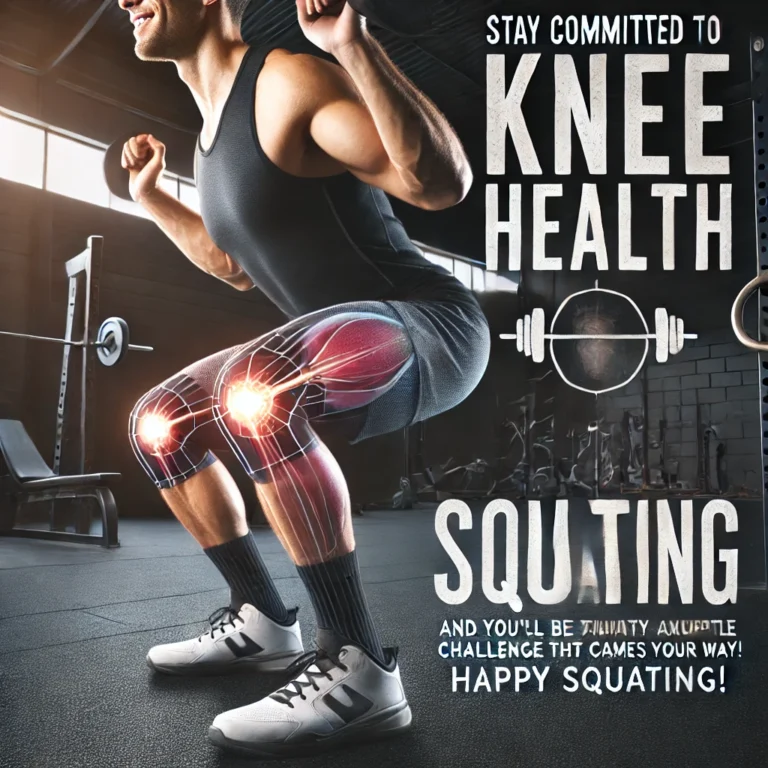Overcoming Patella Pain When Walking Effortlessly
Did you know that walking, a seemingly simple and effortless activity, can cause debilitating patella pain for many individuals?
Research shows that knee pain while walking affects a significant number of people, impacting their daily lives and limiting their mobility. But don’t worry, we’re here to help you find effective strategies and treatments to alleviate patella pain when walking.
In this article, we will explore the causes of patella pain while walking and provide you with practical exercises, posture modifications, and other tips to reduce pain and improve your walking experience. Whether you’re dealing with occasional discomfort or chronic patella pain, our comprehensive guide will empower you to regain control and walk effortlessly once again.
Understanding Patellofemoral Pain
Patellofemoral pain, commonly known as patella pain, is a prevalent issue that can affect both runners and individuals engaging in everyday activities like walking. This type of pain is typically felt at the front of the knee, specifically underneath or around the kneecap. Activities that increase the load on the patellofemoral joint (PFJ) can aggravate this pain, including lunging, squatting, descending stairs, running, and prolonged sitting.
To effectively manage knee pain when walking, it is crucial to understand the causes and contributing factors of patellofemoral pain. By gaining a comprehensive understanding of these factors, individuals can adopt appropriate management strategies and find relief from their symptoms.
“Patellofemoral pain, commonly known as patella pain, can be a significant hindrance to everyday activities like walking.”
The Causes of Patellofemoral Pain
Several factors can contribute to the development of patellofemoral pain when walking. These include:
- Abnormal alignment of the patella
- Weakness or imbalance of the thigh or hip muscles
- Overuse or repetitive stress on the knee joint
- Poor biomechanics or improper movement patterns
These causes can result in increased pressure on the patellofemoral joint, leading to pain and discomfort during walking or other weight-bearing activities.
Managing Knee Pain When Walking
Managing knee pain when walking requires a comprehensive approach that addresses the underlying causes and provides effective relief. Here are some strategies that can help:
- Physical therapy: A qualified physical therapist can design specific exercises and stretches to address muscle imbalances, improve strength and flexibility, and promote proper movement patterns.
- Orthotic devices: Custom orthotics can help correct abnormal alignment or provide additional support to the foot and lower extremities, reducing the pressure on the patellofemoral joint.
- Activity modification: Avoiding activities that exacerbate the pain and incorporating low-impact exercises, such as swimming or cycling, can help minimize stress on the knee joint while maintaining an active lifestyle.
- Pain management techniques: Applying ice packs, using over-the-counter pain medications, or exploring other pain-relieving modalities, such as transcutaneous electrical nerve stimulation (TENS), can provide temporary relief from knee pain.
By implementing these strategies and seeking guidance from healthcare professionals, individuals with patellofemoral pain can effectively manage their symptoms and continue to walk with ease.

| Possible Causes of Patellofemoral Pain | Management Strategies |
|---|---|
| Abnormal alignment of the patella | Physical therapy, orthotic devices |
| Weakness or imbalance of thigh or hip muscles | Exercise programs targeting muscle strength and balance |
| Overuse or repetitive stress on the knee joint | Activity modification, rest and recovery |
| Poor biomechanics or improper movement patterns | Physical therapy, gait analysis, correction of movement patterns |
Strengthening Exercises for Patella Pain Relief
When it comes to reducing pain when walking with patella issues, focusing on strengthening the thigh and hip muscles can be incredibly effective. By targeting these muscle groups, you can not only alleviate pain in the front part of the knee but also improve overall stability.
One set of exercises that can help strengthen the muscles that support the knees and feet are hip abductor exercises. These include side leg raises and side-lying clam exercises. To perform side leg raises, lie on your side with your legs stacked on top of each other. Keeping the lower leg straight, lift the upper leg as high as comfortably possible. Repeat this exercise for both legs.
Similarly, side-lying clam exercises involve lying on your side with your knees bent and stacked on top of each other. Keep your feet together and lift your top knee as high as comfortably possible while keeping your feet in contact with each other. Repeat this exercise for both sides.
In addition to hip abductor exercises, there are other exercises that can strengthen the thigh muscles and provide relief for walking-induced patella pain. Straight leg raises, leg extensions while sitting, wall sits, squats, and step-ups are great options to consider. These exercises target the quadriceps muscles and help improve the overall strength and stability of the knee joint.
| Exercise | Instructions |
|---|---|
| Straight Leg Raises | Lie on your back with one leg straight and the other bent. Lift the straight leg off the ground and hold for a few seconds before lowering it back down. Repeat with the opposite leg. |
| Leg Extensions while Sitting | Sit on a chair with your feet flat on the floor. Extend one leg out in front of you, lifting your foot off the ground. Hold for a few seconds before lowering it back down. Repeat with the opposite leg. |
| Wall Sits | Stand with your back against a wall and lower yourself into a sitting position, as if sitting in an imaginary chair. Hold this position for as long as comfortably possible before standing back up. |
| Squats | Stand with your feet shoulder-width apart. Bend your knees and lower your hips down as if sitting back into a chair. Keep your weight on your heels and chest lifted. Return to the starting position by pushing through your heels. |
| Step-ups | Find a step or bench that is a comfortable height. Step onto the elevated surface with one foot, then bring the opposite foot up. Step back down one foot at a time. Repeat, alternating the leading foot. |
Remember, it is important to start with low-intensity exercises and gradually increase the intensity and duration as your strength improves. If you experience any pain or discomfort during these exercises, it is crucial to consult with a healthcare professional.
By incorporating these strengthening exercises into your routine, you can significantly reduce pain when walking with patella issues and improve your overall mobility and quality of life.

Other Strategies for Managing Patella Pain When Walking
In addition to exercises, there are other strategies that can help treat and provide relief for walking-induced patella pain. These strategies focus on making modifications to posture and support, implementing weight loss and dietary measures, and utilizing medications and alternative therapies.
Posture and Support Modifications
Maintaining a good posture while walking is crucial for minimizing knee strain and reducing patella pain. By ensuring proper alignment of the body, you can alleviate pressure on the knees. Additionally, wearing supportive shoes that provide adequate cushioning and stability can help distribute weight evenly and reduce impact on the patella.
Weight Loss and Dietary Measures
Excess weight puts additional stress on the knees, increasing the risk of patella pain. Losing weight through a balanced diet and regular exercise can significantly relieve pressure on the knee joints. Incorporating anti-inflammatory foods, such as fruits, vegetables, and omega-3 fatty acids, into your diet may also help reduce inflammation in the knees and alleviate pain.
Medications and Alternative Therapies
In some cases, medications can provide temporary relief from patella pain when walking. Non-steroidal anti-inflammatory drugs (NSAIDs) can help reduce pain and inflammation. Topical treatments, such as creams or gels containing menthol or capsaicin, may also provide localized relief. Additionally, alternative therapies like massage, acupuncture, or aromatherapy have been found to alleviate knee pain for some individuals.
It’s important to note that these strategies may not work for everyone, and individual results may vary. Consulting with a healthcare professional is recommended to determine the most appropriate treatment plan for your specific condition.
| Treatment Strategy | Description |
|---|---|
| Posture and Support Modifications | Maintain good posture while walking and wear supportive shoes to minimize knee strain. |
| Weight Loss and Dietary Measures | Reduce excess weight through a balanced diet and incorporate anti-inflammatory foods. |
| Medications | Use non-steroidal anti-inflammatory drugs (NSAIDs) and topical treatments for pain relief. |
| Alternative Therapies | Explore massage, acupuncture, or aromatherapy as complementary treatments. |
The Importance of Proper Technique and Training Loads
Proper running technique and appropriate training loads play a vital role in preventing and managing knee pain while walking. When it comes to patella pain, certain factors like overstriding, high vertical displacement, and improper running technique can contribute to increased stress on the patellofemoral joint, leading to pain and injury.
To prevent knee pain while walking, it is crucial to work with a qualified coach or physical therapist who can assess your running technique. They can provide valuable insights and guidance on how to improve your form, stride length, and foot strike. By making adjustments and practicing proper running mechanics, you can reduce the strain on your knees and minimize the risk of developing patella pain.
In addition to focusing on technique, it is important to gradually increase your training loads to prevent overuse injuries. Pushing yourself too hard or too quickly can put excessive stress on your joints, including the patellofemoral joint. A gradual and progressive approach to training allows your body to adapt and build strength over time.
Remember, everyone’s body is different, and what works for one person may not work for another. It is essential to listen to your body and pay attention to any signs of discomfort or pain. If you experience knee pain while walking, it is crucial to address it promptly and seek professional guidance to ensure an effective and safe training regimen.
Key Takeaways:
- Proper running technique and appropriate training loads are crucial in preventing and managing knee pain while walking.
- Factors like overstriding, high vertical displacement, and improper running technique can increase stress on the patellofemoral joint and contribute to patella pain.
- Working with a qualified coach or physical therapist can help assess and improve your running technique to reduce knee strain.
- Gradually increasing training loads allows your body to adapt and build strength, minimizing the risk of overuse injuries.
- Listen to your body and seek professional guidance if you experience knee pain while walking.
The Role of Imaging in Diagnosing Patella Pain
When diagnosing patella pain when walking, imaging modalities like x-rays and MRI can be useful tools in assessing the condition and ruling out other potential causes. However, it is important to note that imaging is not always necessary for managing this type of pain.
The presence of structural changes in the knee joint, such as cartilage damage or osteoarthritis, does not always indicate the severity or presence of patella pain. In many cases, a thorough history and physical examination are sufficient for an accurate diagnosis.
Imaging techniques are typically reserved for cases where there is a need to visualize the structure of the joint more clearly or rule out other possible conditions that may be contributing to the pain. This can help healthcare professionals make informed decisions regarding treatment and provide targeted care.
It is important to remember that while imaging can provide valuable insights, it should be used judiciously and in conjunction with other diagnostic methods. A comprehensive assessment, including a careful evaluation of symptoms and a physical examination, remains the foundation for diagnosing and managing patella pain when walking.
Tips for Alleviating Patella Pain While Walking
In addition to exercises and treatments, there are practical tips that can help reduce pain and provide relief for walking-induced patella issues. By incorporating these strategies into your routine, you can alleviate discomfort and improve your walking experience.
1. Pay attention to proper body mechanics
When walking with patella pain, it’s essential to maintain proper body mechanics to minimize strain on your knees. Keep your head up, shoulders relaxed, and engage your core muscles for stability. Land softly on your feet and avoid overstriding, as this can exacerbate the pain. By maintaining good posture and form, you can reduce the stress on your patellofemoral joint and alleviate discomfort.
2. Avoid sudden movements
Avoid abrupt changes in direction or quick movements that can put additional stress on your knees. Start and stop walking gradually, and avoid activities that involve rapid pivoting or twisting. By minimizing sudden movements, you can reduce the risk of aggravating your patella pain and allow for a more comfortable walk.
3. Wear comfortable and supportive shoes
Proper footwear plays a crucial role in walking with patella pain. Choose shoes that provide adequate cushioning and support for your feet and knees. Look for walking shoes or athletic shoes with features like arch support and shock absorption. Properly fitted shoes that accommodate the shape of your foot can help distribute pressure evenly and reduce discomfort while walking.
4. Use symptom-modifying techniques
In addition to exercises, other symptom-modifying techniques can provide temporary relief for walking-induced patella pain. This includes taping techniques that provide additional support and stability to the knee joint or orthotic devices that help correct foot alignment and reduce pressure on the patella. Consult with a healthcare professional to determine which technique is most suitable for your specific condition.
Remember to listen to your body and gradually increase your activity levels. Do not push through severe or persistent pain, as this could worsen your condition. If your patella pain persists or intensifies, it is important to consult a healthcare professional for a thorough evaluation and personalized treatment approach.
Conclusion
Alleviating patella pain when walking is possible with effective treatments and strategies. Strengthening exercises play a crucial role in managing patella pain, as they strengthen the thigh and hip muscles, providing stability and relief. Posture modifications and weight loss can also help reduce pain while walking with patella issues.
In addition, proper running technique and appropriate training loads are essential in preventing and managing knee pain while walking. By working on improving running technique and gradually increasing training loads, one can minimize stress on the patellofemoral joint and prevent overuse injuries.
Diagnostic imaging can assist in diagnosing patella pain, although it is not always necessary for management. Diagnosis is primarily based on a thorough history and physical examination, while imaging is reserved for special cases. Symptom-modifying techniques like taping or orthotics, along with comfortable and supportive shoes, can provide further relief.
In conclusion, with a combination of strengthening exercises, posture modifications, weight loss, proper running technique, diagnostic imaging, and symptom-modifying techniques, it is possible to alleviate patella pain when walking. However, it is always recommended to consult with a healthcare professional for personalized advice and a tailored treatment plan to address your specific patella pain concerns.
FAQ
What causes patella pain when walking?
Patella pain when walking can be caused by activities that increase the load on the patellofemoral joint, such as squatting, lunging, running, descending stairs, and prolonged sitting.
How can I manage knee pain while walking?
To manage knee pain while walking, it is important to strengthen the thigh and hip muscles, maintain good posture, wear supportive shoes, and avoid prolonged sitting. Weight loss, dietary measures, medications, and alternative therapies can also provide relief.
Are there exercises that can help alleviate patella pain when walking?
Yes, exercises that target the hip abductor muscles, such as side leg raises and side-lying clam exercises, as well as exercises that strengthen the thigh muscles like straight leg raises, leg extensions, wall sits, squats, and step-ups, can help alleviate patella pain when walking.
Are there other strategies for managing patella pain while walking?
Yes, other strategies for managing patella pain while walking include posture and support modifications, weight loss and dietary measures, and the use of medications and alternative therapies like massage and aromatherapy.
How important is proper technique and training loads in managing patella pain while walking?
Proper running technique and appropriate training loads are crucial in preventing and managing knee pain while walking. Overstriding, high vertical displacement, and improper running technique can increase stress on the patellofemoral joint and lead to pain and injury.
Do imaging modalities play a role in diagnosing patella pain when walking?
While imaging modalities like x-rays and MRI can assist in diagnosing patella pain and ruling out other possible conditions, they are not always necessary for management. Diagnosis is primarily based on a thorough history and physical examination, and imaging is reserved for cases where there is a need to visualize the structure of the joint or rule out other possible conditions.
What are some practical tips for alleviating patella pain while walking?
Some practical tips for alleviating patella pain while walking include paying attention to proper body mechanics, avoiding sudden movements, wearing comfortable and supportive shoes, and using symptom-modifying techniques like taping or orthotics.
How can I overcome patella pain when walking and enjoy a pain-free walk?
By following effective treatments and strategies such as strengthening exercises, posture modifications, weight loss, appropriate training loads, and proper running technique, it is possible to overcome patella pain when walking and enjoy a pain-free walk.







